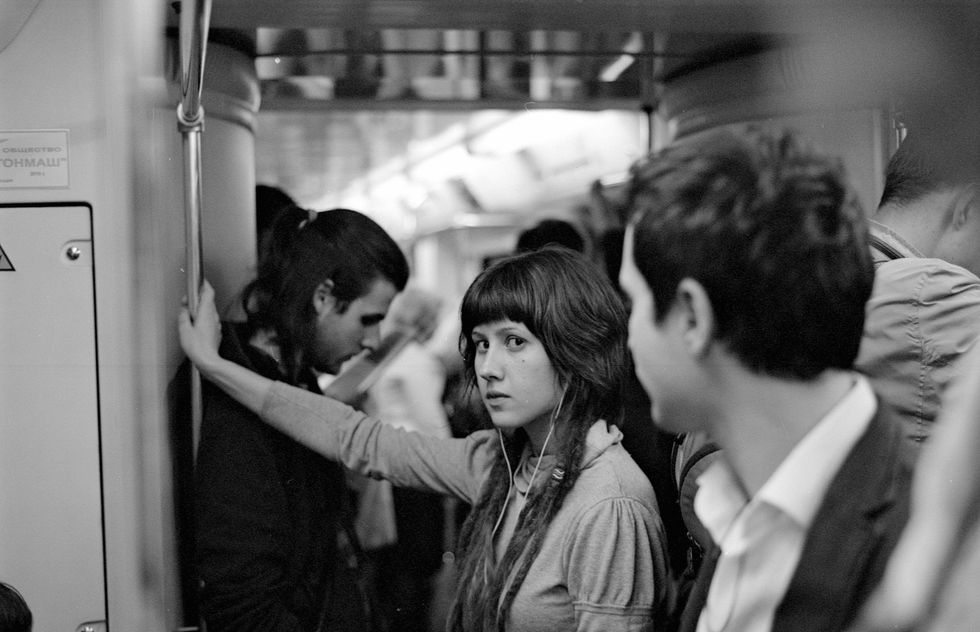When the subway doors opened and he moved next to me, I immediately noticed that he had a tan line on his ring finger where a wedding band should be. Looking up at his weather beaten face, deep lines of exhaustion creased his forehead. He wore a blue Chelsea F.C. jersey, and his stubble was coming in.
Right away, I knew who this man was. It was Joe.
Joe was a divorcée. I could tell they'd separated not long ago, since the tan line on his ring finger hadn't yet faded, and from the look of his sun-kissed skin, he spent his days playing with a local outdoor soccer team during his new period of self-discovery.
Abruptly, the subway lurched to a stop and Joe walked off. While the doors closed, I wondered what his real name was.
Every day, I played this game on my way to my summer internship. Hell, I wasn't called "Nancy Drew" in elementary school for nothing.
I examined any characteristics in the sea of unfamiliar faces around me that distinguished them from their white-static existences in the crowd—how they carried themselves, their nervous tics, how often they checked their watches.
In an act of subway voyeurism, I observed people to understand them, to unravel the elusive mysteries that they are.
This searing curiosity led me onto the path of journalism. I began writing profiles on my township's residents for our community magazine, where I played my subway game above ground for the first and last time.
My first profile was on my neighbor. Let's call her Sadie. Sadie had short, fluffy hair of a faded red chestnut color. Her translucent skin stretched across her veiny hands, which shook whenever she talked. She wore red lipstick, and when she smiled, her entire face crinkled with a joy buoyed only by the lightness of her spirit.
I saw her as the grandmother who sat on the sidelines of her grandchildren's soccer games, who disciplined them gently yet purposefully. She looked like a person who stayed in during the evenings, sipping on chamomile tea. Her existence appeared peaceful and quaint.
I could kick myself now over just how wrong I was.
When we sat down together, I kept these observations in mind. It was when she spoke, though, that a sudden and seismic shift surged through me. Her lips parted and out poured the story of how, decades ago, my elementary school was saved from being bulldozed for real estate—all thanks to her, the sweet old lady before me who had a lot more guts than her gentle smile let on.
It felt like a sucker punch, like I'd sat down with Joe and the other subway commuters and learned in explicit detail exactly how wrong I was about all of them — about everything. Because in that moment, I realized that people are limitless, boundless enigmas, each layer of personality complicated by the next.
Whatever profile I constructed about them was shaped by only a glance at their lives, a still breath in the heaving chaos. For Sadie, I saw the grandmother, but I couldn't see the bravery. She threw me off. She surprised me. And I've been looking to feel that surprise ever since.
You see, I'll always have my little subway game. It's a springboard for my curiosity. But from that day in Sadie's home, I reconciled my burning need to understand others with the truth of never being able to. I learned to take both halves of this reality and find beauty in the space in between, in the surprise that people evoke in me with a glance, a word, a story that forever changes how I view them.
It pushes me to listen harder, to continue unraveling. For there are some mysteries, however intangible they may be, that I can never completely solve.
And truth be told, I hope I never do.




 Energetic dance performance under the spotlight.
Energetic dance performance under the spotlight. Taylor Swift in a purple coat, captivating the crowd on stage.
Taylor Swift in a purple coat, captivating the crowd on stage. Taylor Swift shines on stage in a sparkling outfit and boots.
Taylor Swift shines on stage in a sparkling outfit and boots. Taylor Swift and Phoebe Bridgers sharing a joyful duet on stage.
Taylor Swift and Phoebe Bridgers sharing a joyful duet on stage.













